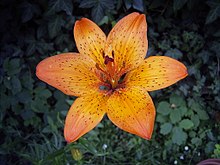

Kingdom: Plantae
(unranked): Angiosperms
(unranked): Monocots
Order: Liliales
Family: Liliaceae
Subfamily: Lilioideae
Genus: Lilium
Lilies are tall perennials ranging in height from 2–6 ft (60–180 cm). They form naked or tunicless scaly underground bulbs which are their overwintering organs. In some North American species the base of the bulb develops into rhizomes, on which numerous small bulbs are found. Some species develop stolons. Most bulbs are deeply buried, but a few species form bulbs near the soil surface. Many species form stem-roots. With these, the bulb grows naturally at some depth in the soil, and each year the new stem puts out adventitious roots above the bulb as it emerges from the soil. These roots are in addition to the basal roots that develop at the base of the bulb.
The flowers are large, often fragrant, and come in a range of colours including whites, yellows, oranges, pinks, reds and purples. Markings include spots and brush strokes. The plants are late spring- or summer-flowering. Flowers are borne in racemes or umbels at the tip of the stem, with six tepals spreading or reflexed, to give flowers varying from funnel shape to a "Turk's cap". The tepals are free from each other, and bear a nectary at the base of each flower. The ovary is 'superior', borne above the point of attachment of the anthers. The fruit is a three-celled capsule.
Seeds ripen in late summer. They exhibit varying and sometimes complex germination patterns, many adapted to cool temperate climates.
Naturally most cool temperate species are deciduous and dormant in winter in their native environment. But a few species which distribute in hot summer and mild winter area (Lilium candidum, Lilium catesbaei,Lilium longiflorum) lose leaves and remain relatively short dormant in Summer or Autumn ,sprout from Autumn to winter, forming dwarf stem bearing a basal rosette of leaves until accept enough chilling requirement, the stem begins to elongate while warming.




No comments:
Post a Comment